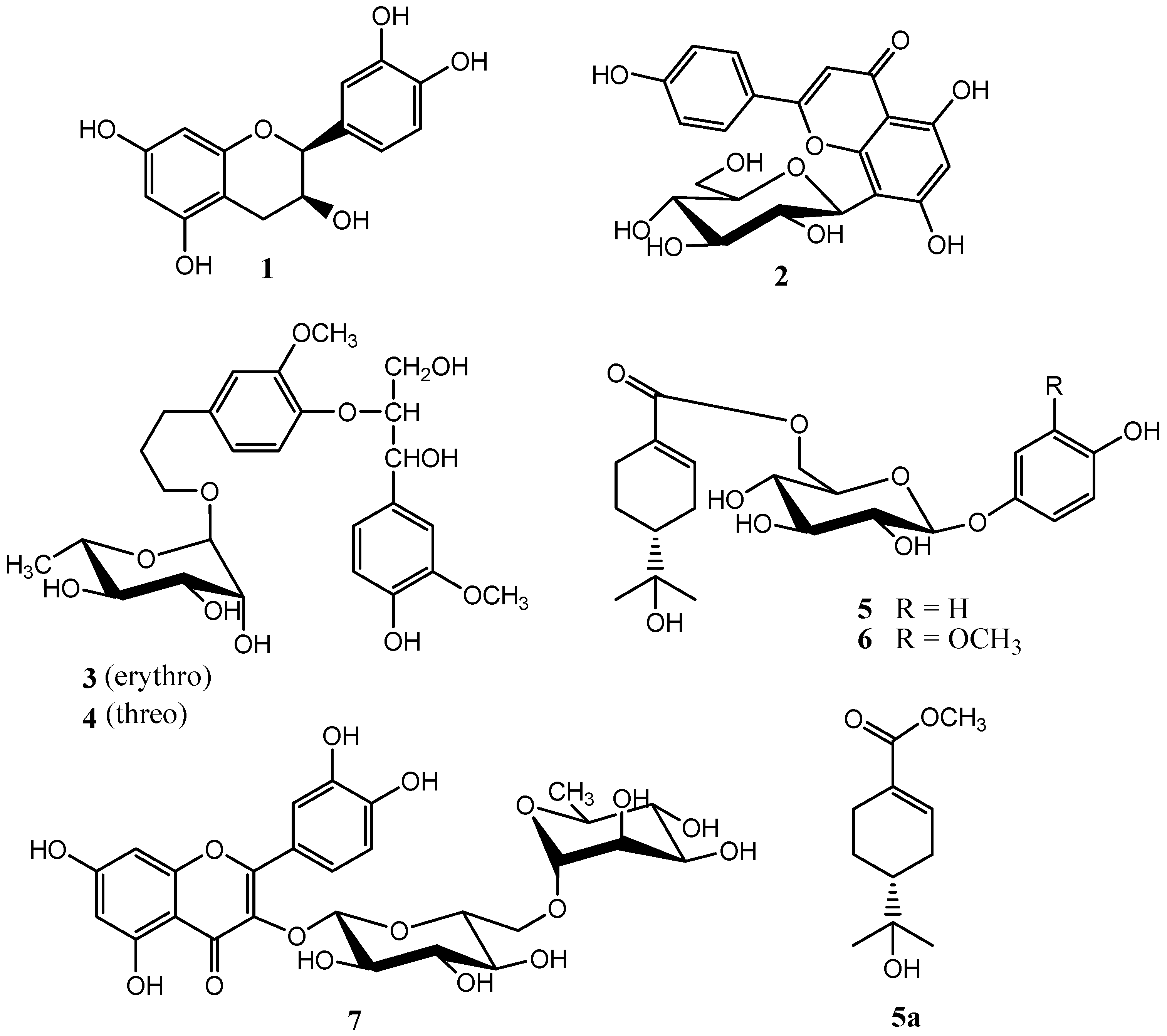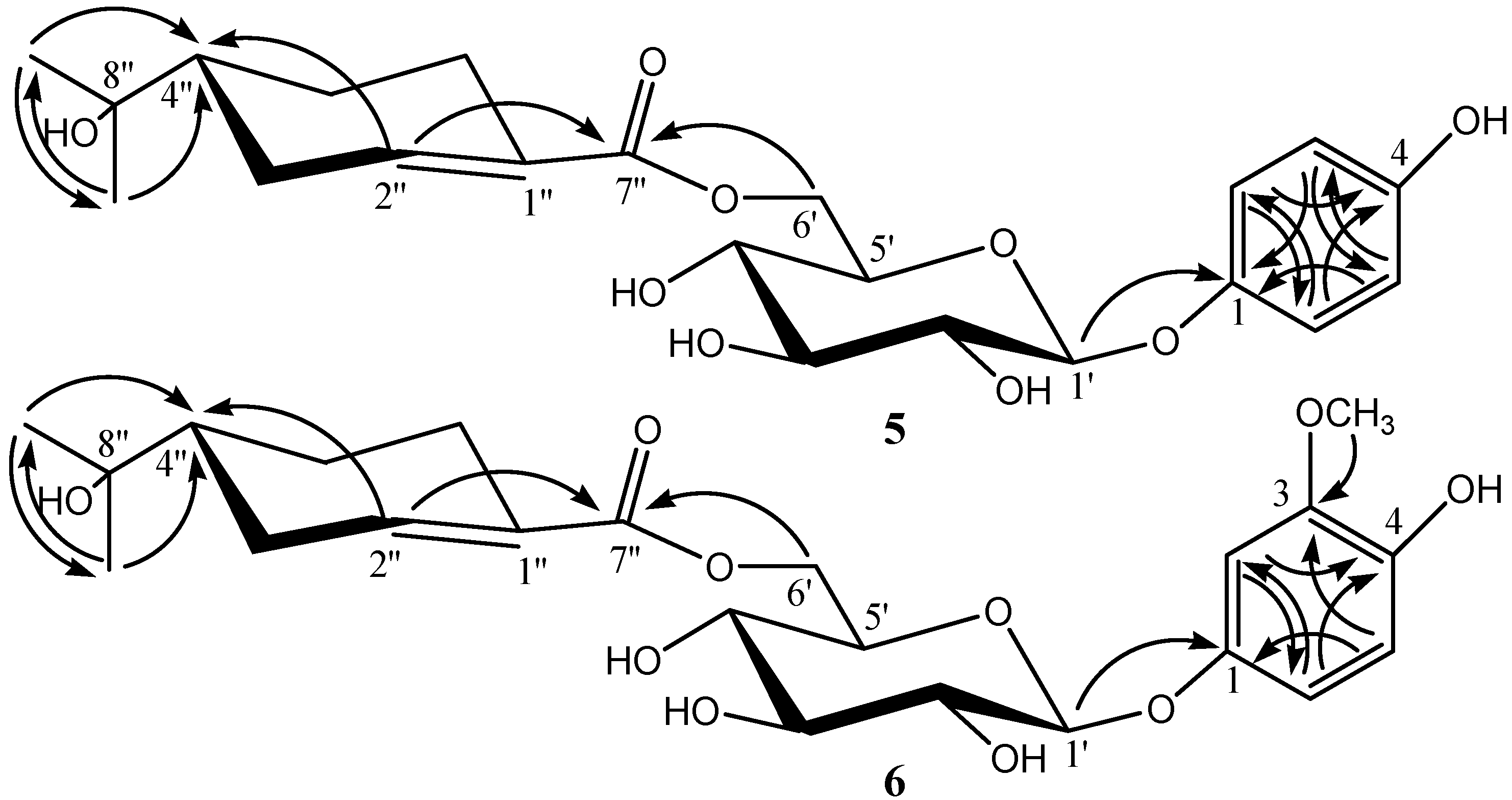Pheonolic Compounds from the Fruits of Viburnum sargentii Koehne
Abstract
:1. Introduction

2. Results and Discussion
| No. | 5 | 6 | ||||
|---|---|---|---|---|---|---|
| δC | δH J (Hz) | HMBC (H→C) | δC | δH J (Hz) | HMBC (H→C) | |
| 1 | 152.1 | 153.0 | ||||
| 2 | 119.5 | 7.03 d (8.7) | 154.3, 119.5 | 104.5 | 6.80 br. s | 143.4, 110.4 |
| 3 | 117.4 | 6.83 d (8.7) | 152.1, 117.4 | 149.2 | ||
| 3-OCH3 | 56.8 | 3.90 s | 149.2 | |||
| 4 | 154.3 | 143.4 | ||||
| 5 | 117.4 | 6.83 d (8.7) | 152.1, 117.4 | 116.2 | 6.75 d (8.2) | 153.0, 149.2 |
| 6 | 119.5 | 7.03 d (8.7) | 119.5, 154.3 | 110.4 | 6.65 d (8.2) | 104.5, 143.4 |
| 1′ | 103.3 | 4.88 d (7.5) | 168.2 | 103.6 | 4.83 d (7.8) | 153.0 |
| 2′ | 75.2 | 3.29 m | 75.2 | 3.51 m | ||
| 3′ | 78.4 | 3.46 m | 78.2 | 3.53 m | ||
| 4′ | 72.2 | 3.36 m | 72.3 | 3.43 m | ||
| 5′ | 75.6 | 3.75 m | 75.8 | 3.71 m | ||
| 6′α | 65.6 | 4.60 d (11.5) | 168.2 | 65.2 | 4.59 d (11.5) | 168.2 |
| 6′β | 4.22 dd (11.5, 7.7) | 168.2 | 4.32 dd (11.5, 7.3) | 168.2 | ||
| 1″ | 131.5 | 131.5 | ||||
| 2″ | 142.2 | 7.04 br. s | 168.2, 29.1, 45.7 | 141.8 | 7.09 br. s | 168.2, 45.4 |
| 3″α | 29.1 | 2.48 d (16.5) | 28.9 | 2.42 d (17.5) | ||
| 3″β | 2.20 m | 2.12 m | ||||
| 4″ | 45.7 | 1.63 m | 45.4 | 1.65 m | ||
| 5″α | 24.9 | 2.16 m | 24.8 | 2.12 m | ||
| 5″β | 1.32 m | 1.32 m | ||||
| 6″α | 26.9 | 2.59 d (16.0) | 26.7 | 2.51 d (16.4) | ||
| 6″β | 2.26 m | 2.21 m | ||||
| 7″ | 168.2 | 169.0 | ||||
| 8″ | 72.2 | 73.2 | ||||
| 9″ | 27.1 | 1.28 s | 45.7, 72.2, 26.6 | 27.3 | 1.38 s | 45.4, 73.2, 26.8 |
| 10″ | 26.6 | 1.28 s | 45.7, 72.2, 27.1 | 26.8 | 1.28 s | 45.4, 73.2, 27.3 |

| Compound | IC50 (µg·mL−1) |
|---|---|
| 1 | 9.85 ± 0.5 |
| 2 | 357.1 ± 6.2 |
| 3 | 520.9 ± 7.6 |
| 4 | 522.3 ± 8.1 |
| 5 | 610.8 ± 6.1 |
| 6 | 620.1 ± 7.3 |
| 7 | 37.5 ± 0.3 |
3. Experimental Section
3.1. General Information
3.2. Extraction and Isolation
3.3. Acid Hydrolysis of 5 and 6
3.4. Methanolysis of 5 and 6
3.5. Bioactivity Assay
4. Conclusions
Acknowledgments
Author Contributions
Conflicts of Interest
References
- The Editorial Board of Zhong Hua Ben Cao of State Administration of Traditional Chinese Medicine of the People’s Republic of China. Zhong Hua Ben Cao, 1st ed.; Scientific and Technical Publishers: Shanghai, China, 1999; Volume 7, p. 599. [Google Scholar]
- Li, Y.B.; Zhang, L.; Yan, J. Study on the cough effect of Viburnum sargentii Koehne fruit. Inf. Tradit. Chin. Med. 2002, 19, 60. [Google Scholar]
- Zhang, C.X.; Chen, H.; Ren, Y.L.; Zhu, J. Study on the antibacterial effect of Viburnum sargentii Koehne fruit extract. J. Anhui Agric. Sci. 2010, 38, 11767–11768, 11782. [Google Scholar]
- Manns, D.; Hartmann, R. Monoterpene glucosides from Cunila Spicata. Planta Med. 1994, 60, 467–469. [Google Scholar] [CrossRef] [PubMed]
- Ito, H.; Koreishi, M.; Tokuda, H.; Nishino, H.; Yoshida, T. Cypellocarpins A–C, phenol glycosides esterified with oleuropeic acid, from Eucalyptus Cypellocarpa. J. Nat. Prod. 2000, 63, 1253–1257. [Google Scholar] [CrossRef] [PubMed]
- Wang, Q.H.; Hubisihalatu; Wu, J.S.; Rong, J.; Narenchaoketu; Dai, N.Y.T. Chemical constituents of Helianthemum ordosicum. Chin. Tradit. Herb. Drugs 2014, 45, 2607–2610. [Google Scholar]
- Li, H.Y.; Sun, J.Y.; Dai, S.W. Stduies on chemical constituents from Phyllostachys pubescens. J. Chin. Med. Mater. 2003, 26, 563–564. [Google Scholar]
- Miyase, T.; Ueno, A.; Takizawa, N.; Kobayashi, H.; Oguchi, H. Studies on the glycosides of Epimedium grandiflorum MORR. var. thunbergianum (MIQ.) NAKAI. II. Chem. Pharm. Bull. 1987, 35, 3713–3719. [Google Scholar] [CrossRef]
- Chen, L.S.; Liang, X.X.; Cai, Z.Y.; Li, L.H. Chemical constituents from Tamarix Chinensis. Chin. Tradit. Herb. Drug 2014, 45, 1829–1833. [Google Scholar]
- Sample Availability: Samples of the compounds 1, 2, 5 and 7 are available from the authors.
© 2015 by the authors. Licensee MDPI, Basel, Switzerland. This article is an open access article distributed under the terms and conditions of the Creative Commons Attribution license ( http://creativecommons.org/licenses/by/4.0/).
Share and Cite
Xie, Y.; Wang, J.; Geng, Y.-M.; Zhang, Z.; Qu, Y.-F.; Wang, G.-S. Pheonolic Compounds from the Fruits of Viburnum sargentii Koehne. Molecules 2015, 20, 14377-14385. https://doi.org/10.3390/molecules200814377
Xie Y, Wang J, Geng Y-M, Zhang Z, Qu Y-F, Wang G-S. Pheonolic Compounds from the Fruits of Viburnum sargentii Koehne. Molecules. 2015; 20(8):14377-14385. https://doi.org/10.3390/molecules200814377
Chicago/Turabian StyleXie, Yang, Jing Wang, Yan-Mei Geng, Zhi Zhang, Yan-Fei Qu, and Guang-Shu Wang. 2015. "Pheonolic Compounds from the Fruits of Viburnum sargentii Koehne" Molecules 20, no. 8: 14377-14385. https://doi.org/10.3390/molecules200814377
APA StyleXie, Y., Wang, J., Geng, Y.-M., Zhang, Z., Qu, Y.-F., & Wang, G.-S. (2015). Pheonolic Compounds from the Fruits of Viburnum sargentii Koehne. Molecules, 20(8), 14377-14385. https://doi.org/10.3390/molecules200814377





